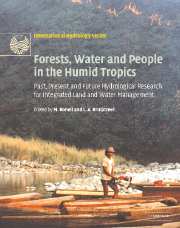 Forests, Water and People in the Humid Tropics
Forests, Water and People in the Humid Tropics Book contents
- Frontmatter
- Contents
- List of contributors
- Foreword
- Preface
- Acknowledgements
- Symposium and Workshop
- Introduction
- Part I Current trends and perspectives on people–land use–water issues
- Part II Hydrological processes in undisturbed forests
- Part III Forest disturbance, conversion and recovery
- Part IV New methods for evaluating effects of land-use change
- Part V Critical appraisals of best management practices
- 35 Guidelines for controlling vegetation, soil and water impacts of timber harvesting in the humid tropics
- 36 Minimising the hydrological impact of forest harvesting in Malaysia's rainforests
- 37 Red flags of warning in land clearing
- 38 From nature to nurture: soil and water management for rainfed steeplands in the humid tropics
- Conclusion: Forests, water and people in the humid tropics: an emerging view
- Plate section
- References
35 - Guidelines for controlling vegetation, soil and water impacts of timber harvesting in the humid tropics
from Part V - Critical appraisals of best management practices
Published online by Cambridge University Press: 12 January 2010
- Frontmatter
- Contents
- List of contributors
- Foreword
- Preface
- Acknowledgements
- Symposium and Workshop
- Introduction
- Part I Current trends and perspectives on people–land use–water issues
- Part II Hydrological processes in undisturbed forests
- Part III Forest disturbance, conversion and recovery
- Part IV New methods for evaluating effects of land-use change
- Part V Critical appraisals of best management practices
- 35 Guidelines for controlling vegetation, soil and water impacts of timber harvesting in the humid tropics
- 36 Minimising the hydrological impact of forest harvesting in Malaysia's rainforests
- 37 Red flags of warning in land clearing
- 38 From nature to nurture: soil and water management for rainfed steeplands in the humid tropics
- Conclusion: Forests, water and people in the humid tropics: an emerging view
- Plate section
- References
Summary
INTRODUCTION
Research and land management experience over many decades has demonstrated that poorly planned or managed logging operations in the tropics generally have a deleterious impact on the ecological and hydrological system (Burgess, 1971; Lal, 1987; Bruijnzeel, 1992; Bruenig, 1996). However, there is also a long history of research and management experience that indicates that, provided forest managers and planners respect broad land capability limits, appropriately managed logging operations can be compatible with the maintenance of hydrological values and high quality water supplies (Gilmour, 1977a, b; Poels, 1987; Baharuddin, 1988; Abdul Rahim, 1990; Bruijnzeel, 1992). On the other hand, despite being known and field-tested in a variety of tropical forested environments for a number of decades now (e.g. Cameron and Henderson (1979), Shepherd and Richter (1985) and Cassells et al. (1984) in north-east Australia; Marn and Jonkers (1981) and Pinard et al. (1995) in Borneo; De Graaf (1986), Jonkers (1987) and Hendrison (1990) in Surinam), available reduced impact logging (RIL) technologies for timber harvesting have often been ignored or inadequately practised in many countries, leading to the generation of unnecessarily high damage to remaining stands, soils and the hydrological system at large (Bruijnzeel, 1992; Bruenig, 1996). Research now being undertaken on the implementation of RIL techniques (e.g. Barreto et al., 1998; Hammond et al., 2000; Pinard et al., 2002) is clarifying many of the key issues associated with the continuation of inadequate management practices in commercial timber harvesting.
- Type
- Chapter
- Information
- Forests, Water and People in the Humid TropicsPast, Present and Future Hydrological Research for Integrated Land and Water Management, pp. 840 - 851Publisher: Cambridge University PressPrint publication year: 2005
References
- 3
- Cited by


